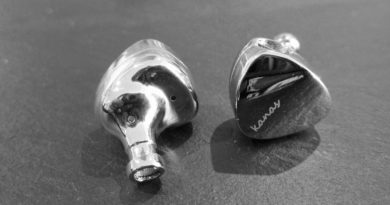Oneodio Studio Max 1 REVIEW – Non-Critical Groove Ready
I have been sent a sample of Oneodio Studio Max 1 headphones with the prayer to take care of them very quickly. Not enough time for a fully thorough analysis but more than enough for some educated experience with them, which you will find here below.
Studio Max 1 retail for € 179,99 in EU and you can find them on the manufacturer’s site (here).
In this Article
At-a-glance Card
| PROs | CONs |
| Extremely low latency (0.02s) when used with the included proprietary M1 wireless transmitter—a key advantage for DJs and gamers. | Comfort is average: while the pads are soft and the headband is tolerable, the earcups are relatively small, making them tight for larger ears. |
| Support for Bluetooth 5.3 and LDAC | Quite heavy at around 350 grams, which may cause fatigue during long sessions. |
| Full-bodied note weight and a pleasant, balanced tonality, roughly aligned with a Harman tuning curve. | Flat and average soundstage. |
| Foldable design makes them compact and easy to transport. | Poor layering. |
| Very long battery life, up to 120 hours (!!) of playback. The figure goes down to “only” 50 hours (!) when the M1 transmitter is involved. | One-note bass with slow-isgìh transients that can muddy the lower mids. Ineffective bass boost toggle. |
| Quick Charge feature gets you back 5 hours playback with only 5 min charging on a totally dry battery | Shouty high-mids that can become fatiguing on certain tracks. |
| Wired listening option available, which notably improves audio quality. | Unextended treble, lacking sparkle and air. |
| Fuzzy imaging and limited instrument separation, with frequent spatial imprecision. | |
| No ANC or DSP features. | |
| Relatively expensive considering the overall sound performance. |
Full Device Card
Test setup and preliminary notes
Sources: My phone + Spotify / My PC with Windows, Luculent A2DP drivers for high end BT codecs, and Roon – stock pads – stock cable – lossless 16-24/44.1-192 FLAC + DSD 64/128/256 tracks.
I am not writing these articles to help manufacturers promote their products, even less I’m expecting or even accepting compensation when I do. I’m writing exclusively to share my fun – and sometimes my disappointment – about gear that I happen to buy, borrow or somehow receive for audition.
Another crucial fact to note is that I have very sided and circumscribed musical tastes: I almost exclusively listen to jazz, and even more particularly to the strains of post bop, modal, hard bop and avantgarde which developed from the late ’50ies to the late ’70ies. In audio-related terms this implies that I mostly listen to musical situations featuring small or even very small groups playing acoustic instruments, on not big stages.
One of the first direct consequences of the above is that you should not expect me to provide broad information about how a certain product fares with many different musical genres. Oppositely, you should always keep in mind that – different gear treating digital and analog sound in different ways – my evaluations may not, in full or in part, be applicable to your preferred musical genre.
Another consequence is that I build my digital library by painstakingly cherry-pick editions offering the least possible compression and pumped loudness, and the most extended dynamic range. This alone, by the way, makes common music streaming services pretty much useless for me, as they offer almost exclusively the polar opposite. And, again by the way, quite a few of the editions in my library are monoaural.
Additionally: my library includes a significant number of unedited, very high sample rate re-digitisations of vinyl or open-reel tape editions, either dating back to the original day or more recently reissued under specialised labels e.g. Blue Note Tone Poet, Music Matters, Esoteric Jp, Analogue Productions, Impulse! Originals, and such. Oppositely, I could ever find an extremely small number of audible (for my preferences) SACD editions.
For my direct and conclusive experience, virtually none of the above is available on the most common streaming platforms, which makes their offering of high sampling material apriori pointless for my purposes. Quite simply, then, I don’t use streaming services as I find them not up to my requested quality.
My source gear is on its turn selected to grant very extended bandwidth, high reconstruction proweness, uncolored amping. Which in particularly means that TWS and any other form of lossless-based wireless gear is apriori off my selection panel.
And finally, my preferred drivers (ear or headphones) are first and foremost supposed to feature solid note-body timbre, and an as magically centered compromise between fine detail, articulated texturing and microdynamics as their designers can possibly achieve.
In terms of presentation, for IEMs I prefer one in the shape of a DF curve, with some very moderate extra pushup in the midbass. Extra sub-bass enhancement is totally optional, and solely welcome if seriously well controlled. Last octave treble is also welcome from whomever is really able to turn that into further spatial drawing upgrade, all others please abstain.
Build and connectivity
The Studio Max 1 are fully foldable, making them easy to pack and carry. They can be used either wired or wirelessly. Wireless playback is available through standard Bluetooth or the included M1 transmitter, which is battery-powered and supports two input modes:
- Digital: via USB connection (ideal for PC or phone).
- Analog: via 3.5mm input (to connect to an amplifier or preamp).
The M1’s proprietary low-latency protocol is a standout feature. Unlike most Bluetooth codecs, this connection is extremely responsive, making it especially useful for real-time applications like DJing (which is the declared main target market for the product) or gaming.
For wired use, the Studio Max 1 support both 3.5mm and 6.35mm single-ended analog connections, and includes two cables in the box.
Controls & Usability
Basic onboard controls are present—volume, play/pause, skip tracks—via buttons on the right earcup. These functions work wirelessly, and can also control some wired sources that support remote commands via analog input.
Sound Quality
Tonally, the Studio Max 1 are quite musical. There’s a satisfying mid-bass emphasis that gives the headphones a fun, groove-oriented character. However, technical refinements are lacking:
- Bass is thick and slow, sometimes bleeding into the lower mids.
- High-mids can become overly aggressive, resulting in a shouty character on vocal-heavy or complex tracks.
- Treble lacks extension and air, which reduces overall detail retrieval.
The soundstage, while not overly narrow, is flat and lacks depth. Layering and imaging are weak points—instrument positioning is often vague or inconsistent.
In essence, the Studio Max 1 are more about vibe than precision. They’re fun to listen to, especially with rhythm-driven music, but fall short for critical listening or analytical use.
Considerations & conclusions
The OneOdio Studio Max 1 are feature-rich, musically engaging headphones designed for practical, on-the-move usage. They’re ideal for DJs, streamers, or anyone needing low-latency performance and high portability. However, they fall short in technical aspects like resolution, imaging, and refinement—areas where audiophile listeners will be left wanting.
If you’re after a punchy, wireless experience with long battery life and reliable low-latency, the Studio Max 1 could be a strong, if nor too inexpensive pick. Just don’t expect studio-grade accuracy.
Our generic standard disclaimer.







